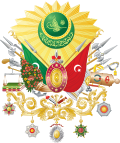
Back موسيقى كلاسيكية عثمانية Arabic Osmanlı musiqisi Azerbaijani Türkische Kunstmusik German Música clásica otomana Spanish Musik Utsmaniyah ID Musica classica ottomana Italian オスマン古典音楽 Japanese Отоманска музика Macedonian Muzik Uthmaniyah Malay Música clássica otomana Portuguese
| Culture of the Ottoman Empire |
|---|
 |
| Visual arts |
| Performing arts |
| Languages and literature |
| Sports |
| Other |
Ottoman music (Turkish: Osmanlı müziği) or Turkish classical music (Turkish: Klasik Türk musıkîsi, or more recently Türk sanat müziği, 'Turkish art music') is the tradition of classical music originating in the Ottoman Empire. Developed in the palace, major Ottoman cities, and Sufi lodges, it traditionally features a solo singer with a small to medium-sized instrumental ensemble.
A tradition of music that reached its golden age around the early 18th century, Ottoman music traces its roots back to the music of the Hellenic and Persianate world, a distinctive feature of which is the usage of a modal melodic system. This system, alternatively called makam, dastgah or echos, are a large and varied system of melodic material, defining both scales and melodic contour. In Ottoman music alone, more than 600 makams have been used so far, and out of these, at least 120 makams are in common use and formally defined.[1] Rhythmically, Ottoman music uses the zaman and usûl systems, which determine time signatures and accents respectively. A wide variety of instruments has been used in Ottoman music, which include the turkish tanbur (lute), ney (end-blown reed flute), klasik kemençe (lyra), keman (violin), kanun (zither), and others.
Until the 19th century, in which Westernization caused Western classical music to replace the native Ottoman tradition, Ottoman music remained the dominant form of music in the empire, and therefore evolved into a diverse form of art music, with forms such as the peşrev, kâr and saz semaî evolving drastically over the course of the empire's history, as the Ottomans' classical tradition also found its place outside of the court. By the end of the 18th century, Ottoman music had incorporated a diverse repertoire of secular and religious music of a wide variety of musicians, including post-Byzantine music, Sephardic music and others.
19th century Ottoman elites saw Ottoman music as primitive and underdeveloped in relation to Western music, and stopped its courtly patronage. This resulted in many classical musicians being forced to work in entertainment-related contexts, and gave rise to a much simpler style, named gazino. After the Ottoman Empire collapsed, the new republican elite tried to suppress Ottoman music further, in an attempt to hasten the process of Westernization. The decline which followed resulted in drastic changes in Ottoman music, and as the new republican elite failed to create an alternative to Ottoman music, the remnants of Ottoman tradition were appropriated and nationalized by the 1980 military regime.
- ^ "MAKAM – TDV İslâm Ansiklopedisi". TDV İslam Ansiklopedisi (in Turkish). Retrieved 18 September 2021.
© MMXXIII Rich X Search. We shall prevail. All rights reserved. Rich X Search